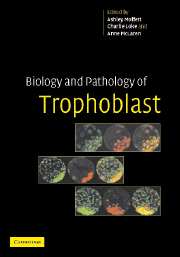Book contents
- Frontmatter
- Contents
- List of contributors
- List of participants
- Preface
- Chair's introduction
- 1 Trophoblast cell fate specification
- 2 Stem cells: pluripotency and extraembryonic differentiation in the mouse
- 3 Epigenetic regulation of trophoblast development
- 4 Regulation of X-chromosome inactivation in relation to lineage allocation in early mouse embryogenesis
- General discussion I
- General discussion II
- 9 Molecular signalling in embryo–uterine interactions during implantation
- 10 Trophoblast and pre-eclampsia
- 11 Trophoblast and uterine mucosal leukocytes
- 12 Immunology of trophoblast: a reappraisal
- Final general discussion
- Index
- Plate section
- References
11 - Trophoblast and uterine mucosal leukocytes
from General discussion II
Published online by Cambridge University Press: 07 August 2009
- Frontmatter
- Contents
- List of contributors
- List of participants
- Preface
- Chair's introduction
- 1 Trophoblast cell fate specification
- 2 Stem cells: pluripotency and extraembryonic differentiation in the mouse
- 3 Epigenetic regulation of trophoblast development
- 4 Regulation of X-chromosome inactivation in relation to lineage allocation in early mouse embryogenesis
- General discussion I
- General discussion II
- 9 Molecular signalling in embryo–uterine interactions during implantation
- 10 Trophoblast and pre-eclampsia
- 11 Trophoblast and uterine mucosal leukocytes
- 12 Immunology of trophoblast: a reappraisal
- Final general discussion
- Index
- Plate section
- References
Summary
Introduction
The mucosal lining of the uterus is transformed from endometrium in the non-pregnant state to the decidua of pregnancy. This transformation is induced under the influence of progesterone and is associated with leukocyte infiltration (Loke & King 1995, King 2000). In decidua, 70% of the infiltrating leukocytes are CD56bright natural killer (NK) cells together with some macrophages. Only small numbers of T cells are present (5%–15% of leukocytes) and B cells are virtually absent (King et al. 1989). Thus, at the site of trophoblast invasion in the first trimester, an influx of cells of the specific adaptive immune system does not occur so it seems unlikely that a maternal classical immune response to trophoblast is generated in the decidua. In contrast, there is an accumulation of innate immune cells, such as NK cells and macrophages at the implantation site. Recently, a population of dendritic cells (DCs) have been isolated and characterised from human decidua which have the phenotype of immature myeloid DCs (Gardner & Moffett 2003).
Uterine NK cells
The infiltration of uterine (u)NK cells is a part of the cyclical changes of the endometrium and it is clearly influenced by sex hormones, particularly progesterone. Recently, endometrial-derived interleukin (IL)15 and prolactin have been implicated in the proliferation and differentiation of these cells. Both of these hormones are produced by mucosal stromal cells and their production is up-regulated by progesterone as decidualisation occurs (Dunn et al. 2002, Gubbay et al. 2002).
- Type
- Chapter
- Information
- Biology and Pathology of Trophoblast , pp. 223 - 241Publisher: Cambridge University PressPrint publication year: 2006

